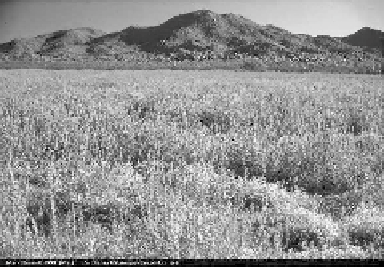Environmental Engineering Reference
In-Depth Information
FIGURE 8.5
Desert bloom following beneficial rainfall in March 1998.
only four drop-everything-and-go-see-it displays in southern Arizona: 1941, 1978, 1979, and
1998. During that period only the displays of 1978 and 1998 were widespread throughout
both the Sonoran and Mohave deserts.
There are three groups of annuals in the Sonoran Desert. Winter-spring species are by far
the most numerous. The showy wildflowers that attract human attention will germinate
only during a narrow window of opportunity in the fall or winter, after summer heat has
waned and before winter cold arrives. In most of the Sonoran Desert this temperature
window seems to occur between early October and early December for most species.
During this window there must be a soaking rain of at least 1 in. (2.5 cm) to induce mass
germination. This combination of requirements is survival insurance: An inch of rain in
the mild weather of fall will provide enough soil moisture that the resulting seedlings
will probably mature and produce seeds even if almost no more rain falls in that season.
(Remember that one of the characteristics of deserts is low and
undependable
rainfall.) If the
subsequent rainfall is sparse, the plants remain small and may produce only a single flower
and a few seeds, but this is enough to ensure a future generation. There is still further
insurance: Even under the best conditions not all of the seeds in the soil will germinate;
some remain dormant. For example, a percentage of any year's crop of desert lupine seeds
will not germinate until they are 10 years old. The mechanisms that regulate this delayed
germination are poorly known.
The seedlings produce rosettes of leaves during the mild fall weather, grow more slowly
through the winter (staying warm in the daytime by remaining flat against the ground),
and bolt into flower in the spring. Since the plants are inconspicuous until they begin the
spring bolt, many people mistakenly think that spring rains produce desert wildflower
displays.
There is a smaller group of annual species that grow only in response to summer rains.
Arizona poppy (
Kallstroemia grandiflora)
) and annual devil's claw (
Proboscidea parviflora)
)
are among the few showy ones. A few opportunistic species will germinate in response
to rain at almost any season; most lack showy flowers and are known only to botanists.
Several species of buckwheats (
Eriogonum
spp.) germinate in fall or winter and flower
the following summer. Finally, the line between annual and perennial is straddled by a
number of species that can live more than one season if conditions are favorable. One of
our commonest wildflowers is in this group; desert marigold (
Baileya multiradiata
) flowers
a few months after germinating and can be annual, but may survive for a few years in
Arizona Upland where the dry seasons are usually short and not severe (Figure 8.6).

Search WWH ::

Custom Search